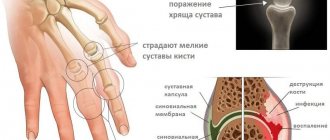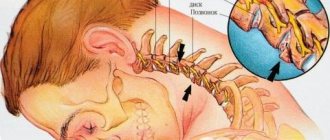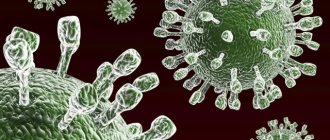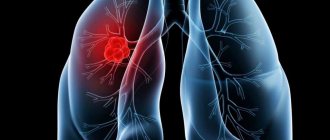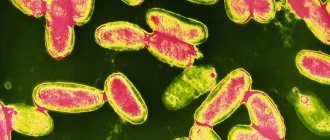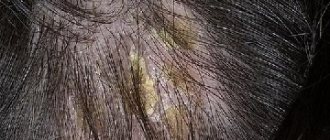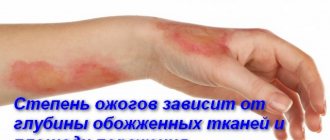Pain in the legs and buttocks is called sciatica. It is associated with chronic osteochondrosis or intervertebral hernia. The material discusses the main symptoms, exercises and treatment of the sciatic nerve at home, which will help cope with the pathology.
Related articles:
Find out what injections are given for pinched sciatic nerve Pinched sciatic nerve during pregnancy - treatment How to do exercises correctly when the sciatic nerve is pinched Pinched nerve in the cervical spine: how to treat? Pinched nerve in the hip joint: symptoms and treatment
Causes of the disease
Pinching can occur for a huge variety of reasons. In this case, the person feels severe pain, suffers from restricted movements and neurological disorders. In addition, as a result of pinching in a certain area of the sciatic nerve, an inflammatory process may begin, which will aggravate the situation.
It is important to know the causes of pinched sciatic nerve, because the speed and success of treatment largely depends on their understanding. Let's consider the most common causes and factors of this pathological process:
- Physical damage. These are all kinds of injuries to the back, pelvis or leg. These include not only fractures; pinching occurs during impacts, falls, bruises, sprains, and dislocations. Particularly dangerous are spinal injuries that lead to displacement of the vertebrae.
- Pathologies of the spine, the most common of which is lumbar osteochondrosis. In the lumbosacral region, a hernia, displacement of the structures of the spinal column, sacral radiculitis, as well as other diseases of the joints and spine can form.
- A pinched nerve with its further inflammation can be triggered by an acute inflammatory process in the pelvic area. Inflammations can be infectious or non-infectious, localized in organs or damaged tissues (soft, bone, etc.), sepsis is especially dangerous.
- Sometimes problems with the sciatic nerves are provoked by infectious diseases such as influenza, whooping cough, and tuberculosis.
- The development of gouty processes cannot be written off.
- Piriformis syndrome.
- Infringement occurs due to systemic diseases, one of the most common is diabetes mellitus types 1 and 2.
The last thing worth mentioning is acute intoxication. Mostly we are talking about poisoning from heavy metals or poisons, but severe degrees of alcoholism can cause nerve damage from toxins.
In fact, there are several more reasons for pinching and inflammation of the sciatic nerve, these include blood clots, multiple sclerosis and even banal external factors, such as hypothermia of the back or hip area.
Therapy methods
Treatment of sciatica at home involves the use of traditional and non-traditional methods of therapy under the supervision of a physician. Traditional medicines include medications and therapeutic complexes based on physical exercises, while non-traditional medicines include treatment with folk remedies. These methods are not mutually exclusive, but rather complement each other.
After the neurologist tells you how to treat at home, you will need to visit him every 3 or 5 days in order to monitor the effectiveness of the measures taken. If there are no results, the neurologist increases the dosage of medications or prescribes new ones.
Drugs
Medications will help save the sciatic nerve from inflammation. Usually these are tablets and ointments with different effects, sometimes injection therapy is possible.
In order to relieve pain, it is necessary to eliminate inflammation. NSAIDs will cope with this:
- Phenylbutazone;
- Ketorol;
- Diflunisal;
- Sulindak.
These drugs are produced in the form of tablets and capsules; with the permission of a doctor, you can use any other drugs with the same effect. In addition, you can use preparations for external use - gels and ointments. The most effective of them:
- Diclofenac;
- Voltaren Emulgel;
- Indomethacin.
Symptoms
As mentioned earlier, pinching one of the longest nerves in the human body threatens to develop very unpleasant symptoms. The clinical picture is full of neurological and physiological symptoms, but the main clinical sign is pain.
In order to see a doctor in time, you need to have a complete understanding of what the symptoms of a pinched sciatic nerve are:
- The main symptom is pain, which varies in nature, character, and specificity. In 80% of cases, the pain is extremely intense and acute. They are classified as piercing, cutting, and can stab so hard that some patients faint. At the same time, the pain comes and goes, appearing as much as it disappears.
- However, in some cases the nature of the pain is dull and aching. In such situations they are always less acute, but often permanent. Because of the pain, a person’s mobility is severely limited, the pain syndrome intensifies during intense exercise, careless and sudden movements, and sometimes even interferes with sleep.
- In addition, the pain is often radiating, for example, if the infringement occurs in the lower back, the pain radiates to the pelvis and thigh. If we are talking about pain in the leg, it can spread throughout the lower limb.
- Painful sensations are accompanied by a tingling sensation on the surface of the skin along the pinching path, numbness or a feeling as if goosebumps are running across the skin.
- A clear sign of neurological disorders caused by impaired innervation is a decrease or increase in sensitivity in certain areas.
- As the pathological process progresses, control of the leg by the damaged sciatic nerve may be lost. Initially, this appears as minor problems in controlling the limb due to muscle weakness, but then complete paralysis may set in.
- One of the signs of neurological abnormalities is dry skin. In addition, many patients complain of excessive sweating of the feet.
- There is a decline in reflex functions in the leg on the side of the body where the injury occurred.
- Disorders of the pelvic organs associated with compression of the nerve canals of the sciatic nerve, which belong to the peripheral nervous system. This development of pathology is accompanied by problems with urination, defecation, etc.
It is important to understand that, according to statistics, pain in the lumbar region is diagnosed less frequently in women. At the same time, men may experience symptoms of inflammation of the prostate gland. There is another interesting fact - in the fairer sex, pain is more often localized in the right buttock, while men more often suffer from pain in the left buttock.
In addition to the clinical signs mentioned, it is important to mention more specific ones:
- Symptom of sitting – the patient finds it difficult or painful to squat, or this action is impossible.
- Lasègue's symptom - the patient is unable to independently lift his leg, the action is responded by severe pain in the lumbosacral spine.
- Sicard's symptom - in this case, an attempt to flex the leg in the foot responds with a strong pain attack.
Sicard syndrome
Lasègue syndrome
Due to the fact that in the pelvic area the sciatic nerve branches into 2 processes, rushing to the left and right legs, in most cases the symptoms are one-sided. That is, when pinched, inflammation of one process occurs, or the pinching itself occurs only on the left or right. Cases of mutual nerve damage are extremely rare, but still occur in medical practice.
In addition, if the sciatic nerve is pinched and inflamed in the lumbosacral region of the spine, if the pathology progresses, it can lead to neurological problems in both lower extremities.
Folk remedies
You can supplement complex treatment at home with folk remedies:
Tinctures and decoctions:
- Pour in 2 tsp. horse chestnut fruit 500 ml of boiling water, place in a steam bath, simmer for 15 minutes. Filter, drink 100 ml before meals.
- Brew 2 tbsp. l dry calendula 440 ml boiling water, cover with a lid, leave for 2 hours. Strain, drink 110 ml three or four times before meals.
- Pour 1 tbsp. l. burdock root (chopped) 220 ml Cahors. Heat the liquid for 5 minutes. Filter, drink 110 ml before morning and evening meals.
Baths:
- Grind 100 g of horseradish root (fresh), put in a fabric bag, put in hot water. Stay in the bathroom for up to 5 minutes.
- Pour 3 liters of boiling water over 1 kg of young pine shoots, boil for 10 minutes. Leave for 4 hours, then pour the broth into warm water (1 liter of medicine per 15 liters of water). Take a bath for about 15 minutes.
Carefully. Taking a hot bath is prohibited for heart pathologies, varicose veins, and gynecological diseases.
Rubbing:
- Pour 100 g of dry acacia with vodka (300 g), leave in a warm place for 7 days. Apply the liquid to the affected area.
- Pour 2 tbsp. l. dry white lilac 300 ml of vodka, leave for a week. Rub three or four times a day.
- Squeeze the juice from the black radish, mix with honey (3:1). Rub your back for 2 – 3 minutes.
- Pour 220 ml of vodka into 20 sheets of dry laurel and leave for 3 days. Treat the affected area to reduce pain.
- Grind 10 Analgin tablets, dissolve the powder in 200 ml of vodka, add 1 tsp. iodine (5%), leave for 3 days in a dark place. Treat your back and limb with the solution, and then insulate it with a woolen scarf.
Compresses:
- Heat a piece of beeswax, make a cake out of it, place it on the sore spot, cover with cling film, and wrap it in a woolen scarf. Apply a compress at night. Repeat the procedure for a week.
- Scald several cabbage leaves in boiling water, apply to the affected area, secure with film and a thick cloth. After 2 - 3 hours, remove and apply a new bandage.
- Mix grated horseradish root, grated potatoes, 1 tbsp. l. honey, stir. Apply vegetable oil to the sore spot, then put the prepared mixture, cover with gauze, cellophane, and secure with thick material. The medicinal mass causes a slight burning sensation. Use after 1 day.
- Mix turpentine with water (1:2), apply the mixture to a slice of black bread, apply to the affected area, cover with a film or woolen cloth. Keep the bandage on for 15 minutes, but if a strong burning sensation occurs, you can remove it earlier. This is an effective remedy, but there is a risk of burns.
These remedies will not help cure sciatica, but they will alleviate the patient’s condition with complex therapy.
Diagnosis of pinched sciatic nerve
Pinched sciatic nerve can be recognized by its characteristic clinical picture. However, some symptoms, in addition to pain, do not always appear and special diagnostic measures are required to confirm the diagnosis. Diagnostics is as follows:
- An initial examination by a doctor is necessary to collect anamnesis, identify complaints, as well as clarify the nature, location and intensity of painful sensations.
- X-ray is a mandatory procedure that allows you to determine and confirm the exact location of the infringement and identify the inflammatory process. This method also excludes damage to bone tissue and the connection of the disease with the spine.
- Computed tomography is one of the main diagnostic methods, as it makes it possible to obtain more detailed information. A CT scan is done in the lumbar region, pelvis, and legs.
- Magnetic resonance imaging is an even more advanced examination method, which is necessary in cases where there is a suspicion that the cause of the disease is damage to the spinal cord and its roots. These lesions cannot be determined by CT behavior, so they resort to the use of MRI.
First aid
If an attack of sciatica occurs unexpectedly (as most often happens), you must immediately lie down on a flat and moderately hard surface. You should not lie on a sagging mattress or soft feather bed, sagging mesh or bare floor. For a patient with sciatic neuralgia, an orthopedic or simply a very elastic mattress is ideal.
It is best to first take a pose on your side, and after a while roll over onto your back. To relieve the load on the spine and ease the pain, you need to place a pillow or a rolled blanket under your knees or shins.
With a strong lumbar curve, you can even put your feet on a low chair. Some people find it more comfortable to lie on their stomach, but then you should elevate the abdominal area, also using a pillow or blanket.
Methods for treating a pinched sciatic nerve
Pinching of the sciatic nerve is a complex pathological process that precludes any attempts at self-medication. To combat pathological processes, be sure to consult a doctor, who, based on diagnostic data, will make an accurate diagnosis and prescribe appropriate treatment.
In addition, treatment for pinched sciatic nerve always involves an integrated approach, it includes mainly conservative methods. Let us consider the treatment regimen in more detail, paying attention to each method of therapy.
Treatment with medications
Drug therapy is the main method of combating the disease. First of all, we are talking about suppressing the main symptoms and, above all, pain. For this purpose, painkillers, analgesic tablets, ointments and special solutions for external use are prescribed that reduce pain and suppress the inflammatory process (Diclofenac and Menovazin). Some anesthetic injections include a blockade, this is necessary to relieve pain of particular intensity.
Gels, creams and ointments are used mainly for damage to the musculoskeletal system, joints, and spine; they also help relieve pain. In most cases, these are drugs from the NSAID group. They need to be rubbed into the area of the sacrum or damaged joint with light massaging movements.
The drug therapy program necessarily includes vitamin complexes with B vitamins. These can be injections for pinched sciatic nerves, aimed at restoring innervation.
The doctor may resort to the help of muscle relaxants, which in this case have a beneficial effect on the functioning of the peripheral nervous system (“Mydocalm”).
Physiotherapeutic methods
Physiotherapy – Along with medications and drug treatment, physiotherapy is required. UHF, electrophoresis, manual therapy methods, the use of the Kuznetsov applicator, magnetic therapy and other methods are used. The attending physician must decide on the appointment of procedures; he also determines the duration of the course of treatment and the frequency of procedures. Only a full course of treatment, at least 10 sessions, will allow you to quickly and effectively get rid of pain and inflammation.
Massage
To restore a damaged nerve, massage is one of the most effective treatment methods. To cure the injury, massages should also be carried out in a course, done by a specialized specialist. Massages improve the patient’s condition, the therapeutic effect is achieved by stimulating blood circulation in the area of injury, relaxing muscles, and the procedures will relieve pain.
Physiotherapy
Exercise therapy is used primarily for rehabilitation after the main treatment. At first, classes are conducted under the guidance of a physiotherapist, who monitors the correct execution of movements. Then the exercises are performed at home.
It is very important that the patient does not feel pain during exercise; initially the intensity of the exercise is low, but it is gradually increased.
Treatment of a condition such as a pinched nerve requires mandatory medical intervention. Remember, any medications, physiotherapy and other methods of combating pathological processes are prescribed only by a specialist.
Otherwise, you risk worsening the disease or encountering a number of complications due to improper treatment. These may be problems in the functioning of other organs, loss of sensation, or even paralysis.
It is also worth noting that in especially severe cases, surgery must be resorted to to treat the pathology.
Treatment of sciatica at home
Treatment of sciatica is usually carried out at home (the patient is admitted to the hospital in exceptional cases). The doctor chooses treatment methods depending on what caused the inflammation of the sciatic nerve. Typically, treatment is complex and includes medications, massage sessions, exercise therapy, physiotherapy and the use of folk remedies.
Those who treat sciatica at home should follow these recommendations::
- do not sit for more than two hours at a time;
- do not slouch, keep your back straight;
- monitor body weight and prevent obesity;
- place your feet straight;
- do not wear high-heeled shoes;
- consume B vitamins;
- give your back rest at night (it is recommended to sleep lying on your side with your legs bent at the knees).
Drug treatment
Sciatica pain is quite an unpleasant phenomenon that can affect a person’s daily activities. Several exacerbations of sciatica occur throughout the year , and the patient’s main task during these periods is to eliminate the pain syndrome.
Drug treatment of the disease involves the use of:
- nonsteroidal anti-inflammatory drugs that relieve inflammation;
- muscle relaxants;
- epidural drugs, as well as steroid-based drugs;
- B vitamins;
- topical preparations (rubs, creams, ointments, gels) that reduce swelling and pain and improve microcirculation;
- antidepressants.
Physical therapy exercises
Did you know that...
Next fact
Physical therapy gives good results for sciatica. Performing special exercises allows you to get rid of swelling and pain , stimulate metabolic processes in the affected area, and relax the muscles. They can be performed in any comfortable position - standing, sitting and lying down. However, doctors recommend doing exercise therapy in a lying position on a hard, flat surface.
The most effective exercises are listed below:
- Lie on the floor, roll over onto your back, pull your knees to your chest, and grab your buttocks with your hands. Hold this position for no longer than 30 seconds, then straighten your legs and place them on the floor, and place your arms along your body. Repeat the exercise ten times.
- Lie on your side, bend your knees, try to pull them towards you as much as possible. Return to starting position. This exercise perfectly warms up the muscles of the lumbar, thoracic and cervical spine. Repeat the exercise ten times, remembering to pull your toes.
- Lie on your stomach. Raise your body by straightening and bending your arms as if doing push-ups. At the same time, the legs should remain motionless. They usually start with one set of 5 repetitions, then gradually increase the number of repetitions.
These and other exercises can improve the well-being of a patient suffering from sciatica. However, before performing them, you must consult a doctor (physiotherapist or physical therapy specialist).
Be careful! You need to perform the exercises smoothly and gradually. Avoid sudden movements that can provoke muscle spasms and complicate the course of the disease.
Massage
Massage procedures are the most effective and safe way to treat sciatica.
Massage for inflammation of the sciatic nerve is:
Medicinal
. It is an excellent remedy for the prevention of sciatica. You need to do therapeutic massage regularly (every other day or daily). A distinctive feature of this procedure is its intensity: therapeutic massage includes rubbing, squeezing and vibration. The duration of one session can vary from 20 to 60 minutes. Therapeutic massage should be performed by a qualified massage therapist at any time, with the exception of periods of exacerbation.- Relaxing . The basis for prescribing a relaxing massage may be a period of exacerbation or severe pain. This massage promotes the outflow of blood and lymph and relaxes spasming muscles. The result is a rapid reduction in tissue swelling and tenderness. Depending on the type of disease (upper or lower sciatica), you need to massage not only your back, but also your arms and legs.
Therapeutic massage is contraindicated during an exacerbation of the disease, because the flow of additional blood to the tissues will increase their swelling.
Video: “How to cure sciatica of the sciatic nerve yourself?”
Also pay attention to the following articles:
- Read more about the treatment of sciatic nerve sciatica here
- What injections are prescribed for sciatica?
- You can read about vertebrogenic lumboischialgia on the page
Pinched sciatic nerve during pregnancy
Oddly enough, pinching of the sciatic nerve in pregnant women is quite common. Pregnancy can even be called one of the causes of the discussed pathological process or sciatica.
The fact is that as the fetus grows, the load on the lumbosacral spine, pelvic area and legs increases greatly. The disease develops especially often closer to the third trimester and throughout it, as the fetus reaches a large size.
Even if we exclude the possibility of developing problems with the pelvic organs due to pinching, there are a number of other dangers. Constant severe pain threatens the health of the mother and child and can cause developmental delays, increased uterine tone, and even miscarriages.
The difficulty lies in the treatment of pinched nerves in pregnant women, since some drugs are contraindicated for the expectant mother. In such situations, consult a doctor immediately.
Drug treatment
To make the treatment effect better, you need to use ointments or do injections. We list the products for rubbing into the skin:
- Finalgon . It is used to rub problem areas, eliminates pain, and provides an anti-inflammatory effect.
- Viprosal contains viper venom . Before treatment, the skin area needs to be warmed up so that the pain-relieving effect is stronger.
- Betalgon . Stimulates blood circulation of the skin in the problem area, in addition to its analgesic effect.
- Carmolis . The medicine is created using vegetation. The composition includes menthol, Chinese lemongrass, thyme and other beneficial ingredients. The drug also relieves pain.
The following injectables are used to treat pinched sciatic nerves: Aspirin, Ibuprofen, Ketoprofen, Naproxen.
Medicines have contraindications and side effects; you do not need to use them alone. To improve your health, you need a comprehensive approach.
Possible complications and consequences
In the absence of proper treatment for a long time, there is a risk not only of developing an inflammatory process. This pathological process is fraught with the following complications and consequences:
- The so-called consolidation of the pain syndrome, in which it becomes chronic, the pain is intense.
- There is always a risk of dysfunction of the internal pelvic organs. This threatens erectile dysfunction, uncontrolled urination, frequent constipation, and women are at risk of developing infertility.
- Infringement of the saddle nerve is dangerous for women due to menstrual irregularities;
- The disease threatens to decrease libido.
- Often, systematic attacks of pain lead to serious sleep disturbances and chronic fatigue.
- The main complication is loss of sensation in the lower extremities and paralysis.
Compresses
Those people who use external compresses know how to cure the sciatic nerve at home. Compresses are included at the stage when the exacerbation has passed. For this, safe and proven recipes are used at home:
- Hot beeswax. The wax piece is heated and lubricated with it on the skin in the painful area. Apply about 30 layers. Wrap a scarf or woolen scarf over it and can be applied at night.
- Fir oil. Apply to the back and lateral area of the thigh, wrap it on top. It will help relieve pain and relieve inflammation.
- Horseradish root. Fresh horseradish rhizomes are washed and, together with raw potatoes, grated on a fine grater until a paste-like mass is obtained. Potatoes and horseradish are taken equally. Add a spoonful of honey. Transfer the mass to gauze. Place it on the nerve area and warm it with a woolen scarf. The procedure is carried out every other day, but no more than 5 times.
- Rye flour. Dilute the flour a little with water and knead it thicker. You should get a dense cake. It is placed on the painful area, covered with oilcloth and warm wool.
Prevention
Treatment of such a disease is a long and methodical process. In addition, the pathology is accompanied by really severe symptoms and threatens serious complications. For this reason, it is important to try to prevent the development of the pathological process by following simple recommendations.
Prevention of pinched sciatic nerve is as follows:
- It is very important to moderate physical activity and avoid lifting heavy objects. This advice is especially relevant for people engaged in heavy physical labor due to their professional activities or involved in strenuous sports.
- Watch your posture and the posture of your children. You need to sit so that your back is straight. In addition, when working sedentarily, it is important to take breaks and devote them to light warm-up or walking.
- To prevent the disease, it is recommended to sleep on a flat, hard surface. The ideal solution would be to purchase an orthopedic mattress and a low, soft pillow.
- Excess weight leads to various musculoskeletal problems, including obesity which can lead to pinched nerves. This reason is always relevant, and to protect yourself, adjust your weight.
- As a preventive measure, it is also recommended to lead an active lifestyle and play sports. It is best to sign up for a swimming class and regularly hang on the horizontal bar.
Treatment at home
At home, it takes a long time to treat the infringement. It requires patience, adherence to instructions and careful attention to your own condition. The main therapeutic methods include massage procedures, special ointments, and physiotherapy.
You need to massage your lower back and the pinched area for at least half an hour. Only a professional should be involved in this procedure. Dry cups can be used in situations where it is not possible to complete the entire course with a massage therapist.
Doctors' advice for treatment at home:
- Do not sit for more than 2 hours. Warm up periodically.
- When walking, do not twist your legs, place your feet straight.
- Maintain correct posture, do not slouch.
- Provide rest for your back, sleep on your side, bending your knee joints.
- Try to lose weight, reduce the load on the spine.
- Eat foods with high concentrations of vitamin B.
- Do not wear high heels often.
Why does sciatica begin to develop?
Inflammation of this nerve may well be caused by the following factors:
- uncomfortable ambient temperature;
- stressful situations;
- pathologies of the spine, due to which the nerve can become inflamed or pinched;
- spinal injuries;
- diabetes;
- infections;
- lifting too heavy loads;
- lack of physical activity;
- pregnancy;
- drinking alcohol;
- poisoning with any heavy metal;
- gout.
There are many reasons for inflammation of the sciatic nerve
Moreover, sciatica does not necessarily begin because of just one single factor.
There are professions in which the likelihood of getting this pathology is slightly higher than in other jobs. Eg:
- farmer;
- machine operator;
- driver.
It is also exceeded among those whose workplace is not comfortable enough, as well as among smokers.
Also, sciatica can either appear suddenly, for example, due to an injury, or develop gradually, which results from difficult work and/or complications from other pathologies.
Mechanism of disease development
The spine experiences the greatest load when walking. Under the influence of unfavorable facts (wearing uncomfortable shoes, excessive physical activity, age-related changes), intervertebral discs are subject to degenerative processes.
As a result of constant compression of the nerve roots of the spinal cord, lumbosacral radiculitis develops. The disease in its advanced stage is accompanied by acute or paroxysmal pain. Sciatica develops as a result of involvement in the pathological process of not only the roots of the spinal cord, but also the sciatic nerve.
Symptoms
Along the course of the nerve, sensitivity occurs: goosebumps, tingling or numbness are felt. The pain is localized on the back of the thigh, gradually moving down to the lower leg muscles. If it is too strong, the patient may even faint. This occurs when walking, sitting on a hard surface, or standing for a long time. Other symptoms of inflammation in sciatica:
- swelling and redness of the skin;
- increased sweating of the feet;
- difficulty when trying to bend the lower leg;
- temperature increase;
- impaired flexion of toes and rotation of the foot.
Inflammation
According to statistical indicators, in most cases, sciatica affects those who are already thirty years old. Every fourth person in the world experiences back pain. And every fifth case of such pain occurs due to inflammation of the sciatic nerve.
This pathology also has a shorter name - sciatica. He also has neuritis, sciatica, neuropathy. All these terms mean the same thing. By the way, this is not the disease itself, but only a syndrome - a signal from the body about diseases in the lower back and sacrum.
First aid for sciatica
If you feel sharp, burning or cutting pain in the lumbar region, the first thing to do is call a doctor from the clinic.
By acting carefully and according to these recommendations, you will eliminate the risk of exacerbation of the disease:
- Minimize all movements that cause pain. Don't lift heavy objects and put off exercising.
- It is best, before the doctor arrives, to lie down on a hard surface, fixing your legs in a position comfortable for you using a footrest or high pillow. This will relieve your back and allow your muscles to relax. The pain will gradually subside.
Get someone's help.
- Wrap the lower back area with a warm scarf or a special woolen belt.
- on the area of inflammation will help reduce acute pain
In addition to the recommendations listed, you must have medications on hand that will help relieve pain before your medical examination:
- Antispasmodics. Drugs such as “Nise”, “No-Shpa”, “Spazmalgon” “Bral” will help reduce the intensity of pain, and in case of uncomplicated inflammation, completely neutralize it.
- Antihistamines , which will prevent the development of skin irritation and swelling. In addition, these drugs have a certain sedative effect. Among the most famous: “Suprastin”, “Tavigil”, “Zirtek”. Please note that Suprastin also has a hypnotic effect.
- A diuretic drug will also help prevent the formation of edema. Furosemide has proven itself to be an effective and safe medicine. But it should be taken only during periods of exacerbation of inflammation.
- Since sciatica is of an inflammatory nature, it would be justified to take anti-inflammatory drugs , such as Diclofinac, Voltaren. They exist in the form of ointments that are applied to the site of inflammation and in the form of tablets that are taken orally.
When visiting a doctor, it is necessary to clearly and fully describe all pain and symptoms so that the doctor can prescribe the right treatment for you.
Causes of inflammation
Among the main reasons leading to sciatica, it is worth noting the following external and internal factors:
- An inflammatory process that occurs directly in nerve fibers and structures.
- Pinching, which can be caused by muscle spasms. Most often, sciatica is affected by conditions of the gluteal and piriformis muscle structures.
- When a person has a cold in the sciatic nerve, this disease also occurs.
- Excess body weight, which causes intense stress on the vertebrae of the spinal column and, as a result, can cause pinched nerve endings.
- Contusion of the sciatic nerve, which occurs during various injuries and emergency situations.
- Displacement of the vertebrae in the lumbar spine.
- Overheating your lower back can also contribute to this problem.
- Lifting heavy loads.
- Common body diseases such as gout and diabetes.
- A hypodynamic lifestyle, poor occupational hygiene, when a person spends a long time in a sitting position.
- A variety of infectious diseases, such as influenza, tuberculosis or herpes zoster (a type of herpes infection).
- The state of pregnancy and the process of delivery.
Read about how to treat the sciatic nerve during pregnancy here!
- Any diseases of the musculoskeletal system - herniated discs of the intervertebral space, disc displacement, formation of osteophytes, osteochondrosis.
- Alcoholism.
- Intense and long-term stressful situations.
The influence of the profession. For example, neuritis of the sciatic nerve most often affects representatives of such professions as drivers, machine and machine operators, and farmers.
In addition to symptoms, it is necessary to understand that pinching of the sciatic nerve can develop quickly or, conversely, slowly. A problem quickly forms when an injury has occurred. Slowly - in case of various diseases or improper working conditions and difficult working conditions.
Since the symptoms are quite intense in this pathology, a person is always interested in how long it takes to treat the sciatic nerve? Doctors can never reliably answer this question, since cure depends on many factors.
Physiotherapy
When a nerve is pinched in the sacrolumbar region, recreational physical exercise is considered a very effective way to get rid of the pathology and relieve pain. To relax tense muscles, it is recommended to perform the following exercises:
- Lying on your back, raise your legs up, leaning them against the wall. Hold for 10 minutes, stretching the spine.
- Sit on the floor with your legs straight ahead. Moving them one by one, walk on your buttocks first forward, then back.
- Place your feet shoulder-width apart and perform shallow squats, holding onto the back of the chair if necessary.
- Lie on your back, pull your knees to your chest. Then, without straightening your legs, lower them together to one side and the other.
- Lie on your stomach, stretch your arms forward, bend at the lower back. Stay in this position for as long as possible.
- Lie on your back, lift one knee, clasping it with your hands, pull it up, and then to the opposite shoulder. Pause a little, return to the starting position and repeat with the other knee.
- Lie on your back with your legs bent so that your feet are on the floor. Raise your buttocks as high as possible, lifting your shoulders off the floor.
In addition to these, you can perform other exercises for stretching the legs in a lying position, as well as “bicycle” and circular rotations of the hips.
You can engage in physical therapy only during the period of remission. In this case, all exercises should be performed without tension or overcoming pain.
Other causes
Why does sciatica occur (symptoms and treatment of this disease will be presented below)? There are many reasons for the development of this disease. The most common factors are the following:
- regular lifting of weights;
- making sudden movements;
- intense physical activity against the background of a habitual sedentary lifestyle;
- hypothermia;
- severe emotional shock or stress.
Diagnostics
The doctor can make an intermediate diagnosis during the examination of the patient. At the appointment, the neurologist checks the patient's reflexes on the legs by tapping with a hammer. Along with this, the doctor examines the sensitivity of the skin to assess how affected the nervous system is. Additional procedures may be required to confirm the diagnosis, such as:
- Magnetic resonance imaging;
- CT scan;
- radiography;
- biochemical tests in laboratory conditions;
- examination by a surgeon, vertebrologist, rheumatologist.
